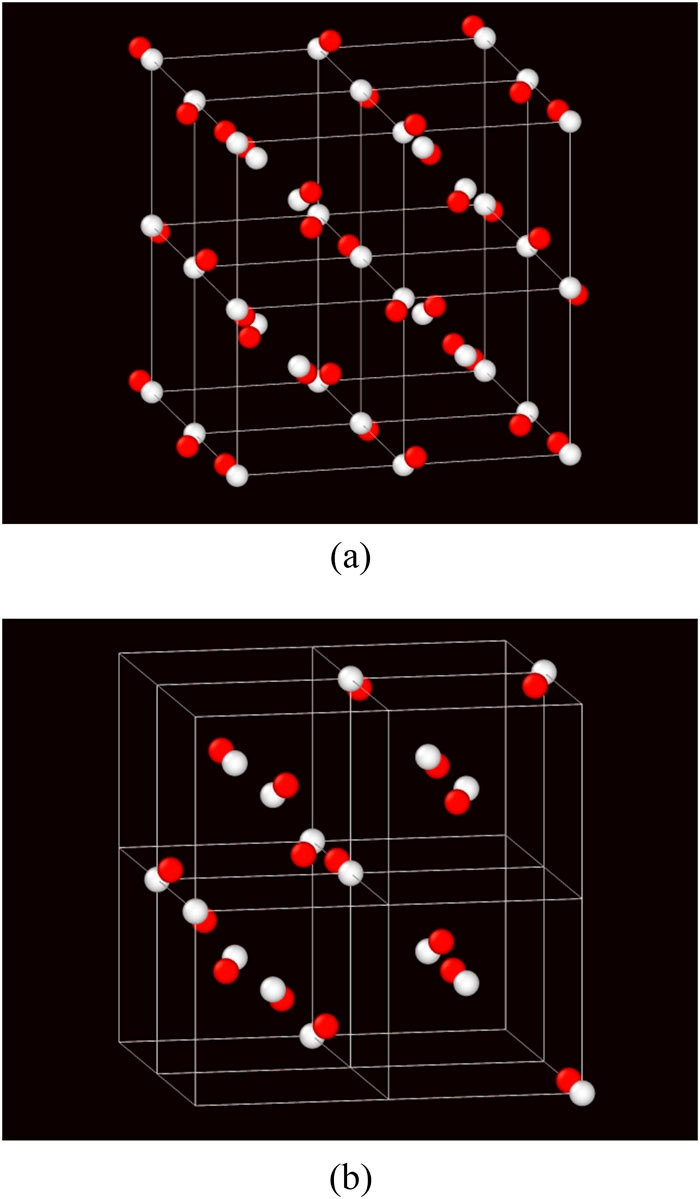Chemical Engineering Professor's Research Featured by American Institute of Physics

Visualization of the unit cell of a cI16 lattice. (a) The white balls mark the centers of 35 atoms in a 2×2×2 supercell of a body-centered cubic lattice. The red balls mark the centers of the 35 atoms in the cl16 lattice. (b) The red balls mark the centers of 16 basis atoms in the unit cell of the cI16 lattice with the white balls showing the corresponding body-centered cubic locations. The system is shown at a low density to clarify the atom locations.
Research by David Ford, a professor of chemical engineering, was featured recently in the American Institute of Physics Scilight publication for its breakthrough findings related to the arrangement of hard particles under pressure. The research has implications for developing photonic crystals for devices that manipulate visible light, such as optical computers and cloaking devices.
Ford is the head of the Ralph E. Martin Department of Chemical Engineering and holds the Ralph E. Martin Endowed Leadership Chair in Chemical Engineering.
The paper, titled "On the mechanical stability of the body-centered cubic phase and the emergence of a metastable cI16 phase in classical hard sphere solids," first appeared in the Journal of Chemical Physics.
Ford, alongside researchers from the University of Massachusetts Amherst, challenged long-held assumptions about the way hard particles pack into crystalline lattices under pressure and discovered a new arrangement that is mechanically stable and thermodynamically metastable, meaning it could be synthesized in the laboratory with standard techniques using micron-sized solid particles. The size of such particles is similar to the wavelengths of visible light, meaning specially designed crystalline structures could be used to absorb, reflect or refract light in a way that affects the visibility of an object.
"Using computer simulation we discovered that hard sphere particles, which interact like billiard balls, will spontaneously form the cI16 crystalline structure under certain conditions," Ford said. "This somewhat rare crystal structure is relatively open and may have optical properties different from the more common close-packed lattices."
The research was done in conjunction with a research laboratory at Johns Hopkins University.
The project was supported by a grant from the National Science Foundation.
Topics
Contacts
Nick DeMoss, director of communications
College of Engineering
479-575-5697,
ndemoss@uark.edu
David Ford, head
Department of Chemical Engineering
479-575-3739,
daveford@uark.edu
Headlines
Four Students Named Goldwater Scholars; Two Earn Udall Honorable Mentions
Four U of A students have received the prestigious Goldwater Scholarship, an award for top students in mathematics, science, and engineering.
Cross-Campus Collaboration Culminates in New Outdoor Geological Installation
Grand opening event to celebrate the new GeoLab installation at the U of A’s Gearhart Hall courtyard is set for May 3. The installation will be open to the public year-round.
First Students to Use Online Degree to Hone Nursing Leadership, Elevate Patient Care
Hanna Baxendale and Wendi Kimbrell will begin coursework in the Doctor of Nursing Practice-Executive Master of Business Administration program offered by the Eleanor Mann School of Nursing and Walton College.
Join the Office for Sustainability on a Final Cruise to Campus
Cruise to Campus Wednesdays have fostered a gathering space for individuals interested in biking to campus. Drop by the Old Main Lawn from 7:30-10 a.m. Wednesday for coffee, something to eat and conversation.
Fay Jones School Student Ambassador Program Gives Voice to Design Students
The student ambassador program at the Fay Jones School of Architecture and Design is built to connect top design students with their school, its alumni, its future students and others inside and outside the school.




